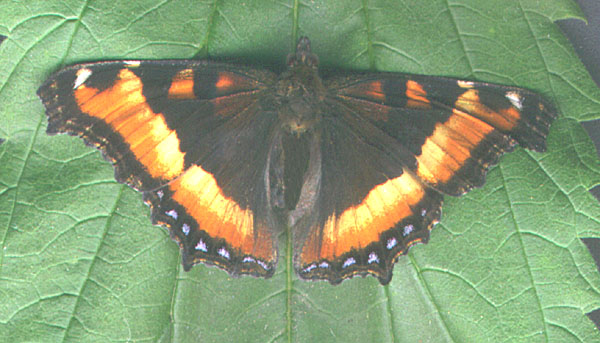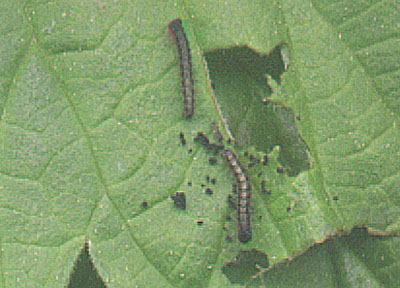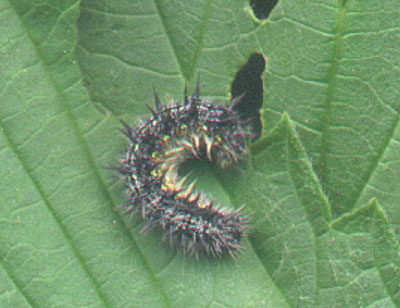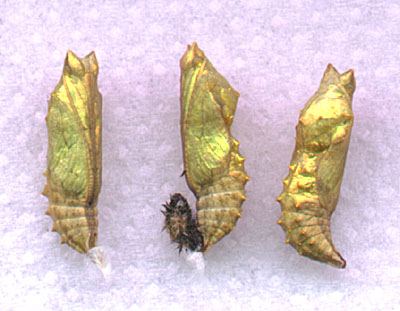Nymphalis milberti: THE MILBERT'S TORTOISESHELL BUTTERFLY
Nymphalis milberti
nim-FAGHHL-ismmmil-BERT-tye

Nymphalis milberti butterfly scan by Bill Oehlke.
This site has been created by
Bill Oehlke at oehlkew@islandtelecom.com
Comments, suggestions and/or additional information are welcomed by Bill.
|
Taxonomy
Superfamily: Papilionoidea Latreille, [1802]
Family: Nymphalidae, Rafinesque, 1815
Subfamily: Nymphalinae, Rafinesque, 1815
Tribe: Nymphalini Rafinesque, 1815
Genus: Nymphalis Kluk, 1780
| | MIDI MUSIC
..........."Danny Boy"............
ON.OFF
<bgsound src="danny.mid" LOOP=FOREVER>
|
The Milbert's tortoiseshell, Nymphalis milberti, flies throughout most of Canada and
northwestern U.S.A.
To my surprise, on April 9, 2004, I spotted a Milbert's tortoiseshell
fluttering around the south side of my house (Montague, Prince Edward Island) , temperature around 6-7C,
45 F. The butterfly colouration and wing structure were of high quality.
Local foodplant for larvae, nettles, has not broken ground yet and
is under at least a foot of snow. The butterfly will probably go back into
hibernation for a couple of weeks.
 |
In late May, 2000, I discovered a cluster of approximately 100 tiny
Nymphalis milberti caterpillars feeding under a grey web at the top of one of my nettle stems.
I brought them inside to protect from predation and parasitization and reared the lot of them
in four two-gallon plastic tubs on cut nettle stems. |

|
The Nymphalis milberti caterpillars progressed very rapidly
but remained rather nondescript throughout their development.
Scan by Bill Oehlke. The gregarious feeding habit continued
throughout most of their larval development. |
 | Within three
weeks of my find, the larvae began hanging in characteristic
"j-shape" and formed rather striking pupae. Pupae of the
Nymphalis milberti butterfly can be removed from their
moorings by gently scraping the silk pads away from the twigs/stems
or other pupation surfaces.
|
Eclosions generally occur within 9-14 days
after pupation, depending upon temperature.
I set the pupae on
some paper towels in the bottom of a five gallon clear plastic tub
and draped some towelling over an end and one side so emerged
butterlies could climb, hang and inflate.
Natural winter hibernation quarters in wood piles, under tree
bark, under shingles, etc., can be matched artificially by drilling
2" diameter holes half way through 2"x4" lumber.
Screening,
stapled over refrigerator chilled butterflies
placed in the excavations, will allow for air circulation.
The
lumber can be stored outdoors under two feet of leaves once the
temperature has dropped to below freezing.
Use your browser "back" button to return to previous page.
Visit other websites maintained by Bill Oehlke:
+++LIVESTOCK AND SUPPLIES FOR SALE***
This site is designed and
maintained
by Bill Oehlke. You can reach Bill for questions
by clicking on his name (email) or by phone 902-838-3455,
or at Bill Oehlke,
Box 476, Montague, P.E.I., Canada C0A 1R0.
I offer two membership sites that far exceed the
coverage offered
on the sites listed above:
THE WORLD'S LARGEST SATURNIIDAE SITE and
CATERPILLARS TOO! North American (Canada/US) Butterfly website

Please click on the flashing butterfly icon to the right
to show
appreciation for this site and to visit other insect sites. Thankyou!
|
 |





